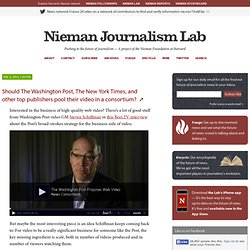

In the Expanding World of Times Video, a Boss 'From Another Planet' When Rebecca Howard came to The Times about six months ago to run its newsroom video-production operation, one of her first moves was to discontinue something called TimesCast.

The setup – a couple of journalists sitting around talking – just didn’t measure up to what she had in mind, she said. Ms. Howard was hired from the AOL Huffington Post Media Group to ramp up video’s importance at The Times. The department’s staff has grown, doubling to 55 from last year. She has hired 17 people since starting in March, with another four to come before the end of the year. The Times is now producing 250 “pieces of content” a month, she told me in an interview last week. Her role may be the most obvious change in the old forms because, as general manager of video production, she reports both to the news and the business sides of The Times – representing, in one person, the way some of the old lines are being blurred.
“We don’t want people to feel inundated” by advertising, she said. Ms. The Times' video dilemma. Early last year, The New York Times was making its first big sales push since revving up its digital video strategy, and it locked down two large upfront deals with two tony advertisers. One was Acura, which signed on for a full year. The other was Microsoft, which wanted a commitment closer to half a year.
Both deals guaranteed these advertisers a "ton" of placement at the beginning of nytimes.com videos, according to a person familiar with the transactions, who said the deal with Acura was worth more than $1 million and Microsoft north of $500,000. The good news was that the Times was finding customers for the sort of lucrative video buys that legacy outlets are eager to secure as they hustle to shore up digital revenues in the face of a spiraling print market. The bad news was that by springtime, it had become apparent that the Times wouldn't be able to deliver on both of these buys.
The Times had originally aimed to close five big video deals in 2013. That needs to change. 2,7 milliards de CA net pour le marché de la publicité digitale en 2013. INFOGRAPHIE - Avec près de 3 milliards d'euros nets, le marché de la publicité digitale 2013 a démontré sa maturité et son potentiel, peut-être encore sous-exploité, dans un contexte difficile pour tous les autres médias.

En 2013, le marché de la publicité digitale a atteint 2,791 milliards d’euros de chiffre d’affaires net, soit une progression de 3% par rapport à 2012, selon la 11ème édition de l’Observatoire de l’e-pub du Syndicat des régies internet (SRI), réalisé par PwC, en partenariat avec l’Union des entreprises de conseil et d’achat médias (UDECAM).
Avec une part du digital dans les dépenses publicitaires à 22%, le marché français continue ainsi sa progression et « rattrape peu à peu les autres pays avancés où cette part est sensiblement plus élevée, à 24% pour les États-Unis, 30% pour l’Allemagne, et 35% pour le UK », souligne l'étude. Le search roi Selon les leviers digitaux, le search poursuit sa croissance (+5%) et consolide sa place de numéro 1 dans le mix digital. Vidéo formats presse en ligne. The Washington Post’s Schiffman Proposes Web Video News Consortium. NY Times, PBS Bring Documentaries Online. Vidéo en ligne et presse écrite : du newspaper au newsplayer ? Vidéo en ligne : la presse écrite rêve de super manne.
Should The Washington Post, The New York Times, and other top publishers pool their video in a consortium? Interested in the business of high-quality web video?

There’s a lot of good stuff from Washington Post video GM Steven Schiffman in this Beet.TV interview about the Post’s broad-strokes strategy for the business side of video. But maybe the most interesting piece is an idea Schiffman keeps coming back to: For video to be a really significant business for someone like the Post, the key missing ingredient is scale, both in number of videos produced and in number of viewers watching them.
Scale matters both because of the obvious CPM math — More Viewers = More Ad Impressions = More $$$ — and because many potential advertisers won’t bother to engage with a video publisher until the number of eyeballs it can offer reaches critical mass. And individual news organizations, even very good ones like the Post, have trouble producing enough videos and views to matter to advertisers. So if you need scale, how do you get it? That’s an interesting idea! — Joshua Benton.